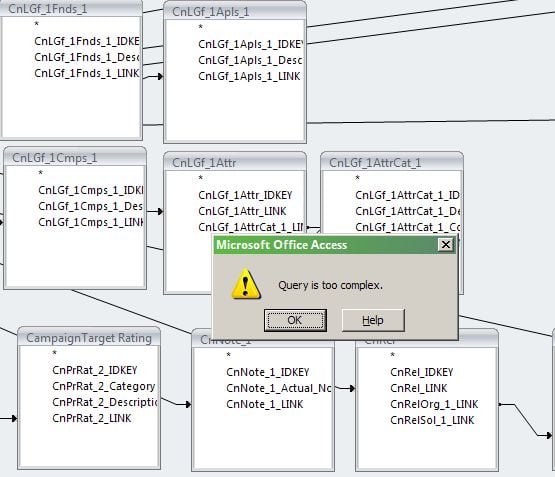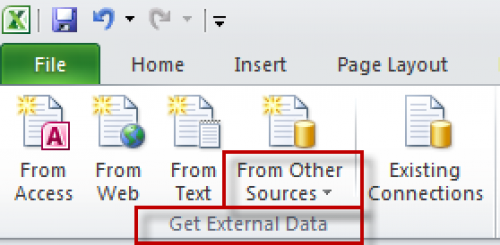Raisers Edge 7 and ODBC
I'm not sure what category this falls under, but my question is how can I go about creating an ODBC connection to our RE database? My goal is to be able to connect to it in MS Excel so that we can build a custom spreadsheet that pulls in various amounts of data into different cells. I don't think this is something I can do as a custom report in RE since my data is going to come from mulitiple queries. Maybe I'm looking in the wrong direction? Any help is greatly appreciated!
Thanks,
Ray
Comments
-
Hi Ray,
Sorry for what might be an annoying question, but if your end goal is reporting, why go through Excel? You could probably run the data directly via SQL/Reporting Services (or a reporting tool of your choice) and "cut out the middle man".
The direct SQL option gives you a lot of data manipulation options as well, with pivots and the like. Plus you can build views for your frequently accessed data.
And then there are the data warehousing options ...
Let me know if I’m on the wrong track here!
Cheers,
Steve Cinquegrana | CEO and Principal Developer | Protégé Solutions
1 -
Ray Berthelette:
Hi All:
I'm not sure what category this falls under, but my question is how can I go about creating an ODBC connection to our RE database? My goal is to be able to connect to it in MS Excel so that we can build a custom spreadsheet that pulls in various amounts of data into different cells. I don't think this is something I can do as a custom report in RE since my data is going to come from mulitiple queries. Maybe I'm looking in the wrong direction? Any help is greatly appreciated!
Thanks,
RaySteve has a point that once you get into the SQL world, Excel becomes a less attractive reporting option than a lot of other things.
That said, some people are comfortable and productive in Excel, and there's a ton you can do with Power Query, so if that's how you want to do it, go for it.
You just need to have permissions on your server. Then it's control panel, administrative tools, data sources, system DSN and create the RE7 connection there.
1 -
Thanks for the reply Steve and James! The reason I'm looking to use Excel is because other people in our office are comfortable with that and and have been using it for years. Trying to teach another method would take some time. With that said, I'm familiar with setting up a DSN, but not sure what Server and credentials I would need to enter in order to connect to RE7. Any idea what that would be?
The SQL Reporting option sounds promising, but again, what are the credentials I would need to connect to our RE7 database?
Thanks,
Ray
0 -
Ray Berthelette:
Hi All:
I'm not sure what category this falls under, but my question is how can I go about creating an ODBC connection to our RE database? My goal is to be able to connect to it in MS Excel so that we can build a custom spreadsheet that pulls in various amounts of data into different cells. I don't think this is something I can do as a custom report in RE since my data is going to come from mulitiple queries. Maybe I'm looking in the wrong direction? Any help is greatly appreciated!
Thanks,
RayThe official "Blackbaud Supported" method is through their RODBA module (included free in upper levels of support contracts).
https://kb.blackbaud.com/articles/Article/75705
1 -
Depending on the version of Excel you're running, you can use Power Query (later called Get & Transform, apparently) as James suggests or, as per my olde worlde 2010 version of Excel, simply, Get External Data. (I guess you can't get clearer than that!)... what are the credentials I would need to connect to our RE7 database?
This, you probably already know.
On the SQL Server end, you can either use Windows Trusted or SQL credentials, depending on your network setup. I'd definitely suggest not using sa Login(!) if using explicit cred.s, so you will probably need to add a server Login (mapped to a DB User). For example, I just did this creating a Login/User "ReportsTest" and it worked fine, pulling every record in the RECORDS table from our sample database.
There's a Microsoft reference you can have a look at which I found by just Googling "Excel SQL connect" (a long URL sitting on my phone starting "support.office.com" if that's any help). It has instructions for most Excel versions. Getting the SQL end right - enough rights but not too much!* - was the fiddliest bit. (* Eg, you probably only need role memberships public and db_datareader.)
Hope that helps.
PS And John's right, RODBA is suggested by BB - and works fine - but you might not currently have it and getting it can be tricky in my experience.
0 -
Thanks Steve. In Excel 2010 it's called Connections. Regardless of if I go in there and try to manually create a connection, or point to a DSN that I created, I'm unable to connect to the RE production database. I tried using the same username and password that I use to connect to RE. I think it's because I need the RODBA module. I have sent an e-mail to BB asking about this and have yet to hear back.
I also see that they use Crystal Reports to create .RPT files that are used in the Reporting tab. I was thinking if I could connect via DSN to the production RE database using Crystal Reports, then I could create my own RPT files and have them included in our install of RE. This way our users only have to run the report.
For now I found sort of a work around. I found that if I create my queries in RE, then export each as an XLSX file, I can then connect to each of these files in my Excel report as a datasource connection. Once I do that I can pull in all of the information into individual sheets in this workbook. I then use the first sheet as my summary page that runs all of the calculations I need. It's not ideal, but it is still faster than how it is being done now, which is running queries and someone manually typing in the data they need into the Excel report.
I'm open to any other suggestions.
Thanks Everyone!0 -
To the left of Connections on the Excel ribbon should be Get External Data. That's where I created the connection that you can then use in Connections, though it's not mandatory to do so.
You can't use a straight RE-created login, not even Supervisor, as the RE client uses an abstracted login (REUSER for which the password is secret/encrypted) through to the back-end (as far as I recall anyway).
As I said, you need to use - or create - a SQL Server Login mapped to a DB User. This gets around needing RODBA but that's hopefully an option open to you.
Cheers, Steve
0 -
Steven Cinquegrana:
To the left of Connections on the Excel ribbon should be Get External Data. That's where I created the connection that you can then use in Connections, though it's not mandatory to do so.
You can't use a straight RE-created login, not even Supervisor, as the RE client uses an abstracted login (REUSER for which the password is secret/encrypted) through to the back-end (as far as I recall anyway).
As I said, you need to use - or create - a SQL Server Login mapped to a DB User. This gets around needing RODBA but that's hopefully an option open to you.
Cheers, Steve
I don't have "Get External Data" in my version of Excel, but I do have "From Other Sources". I go there and select "From SQL Server", enter the name of the Server using Windows Authentication, and then when I go to select the database my only options are "master, msdb, tempdb". The name of our production database does not show up. I'm guessing this is because it is hidden by RE. I tried using my RE login and that doesn't work. At this point it doesn't matter which user I use because I don't think the table is exposed.
Thanks,
Ray0 -
Categories
- All Categories
- Shannon parent
- shannon 2
- shannon 1
- 21 Advocacy DC Users Group
- 14 BBCRM PAG Discussions
- 89 High Education Program Advisory Group (HE PAG)
- 28 Luminate CRM DC Users Group
- 8 DC Luminate CRM Users Group
- Luminate PAG
- 5.9K Blackbaud Altru®
- 58 Blackbaud Award Management™ and Blackbaud Stewardship Management™
- 409 bbcon®
- 2.1K Blackbaud CRM™ and Blackbaud Internet Solutions™
- donorCentrics®
- 1.1K Blackbaud eTapestry®
- 2.8K Blackbaud Financial Edge NXT®
- 1.1K Blackbaud Grantmaking™
- 527 Education Management Solutions for Higher Education
- 1 JustGiving® from Blackbaud®
- 4.6K Education Management Solutions for K-12 Schools
- Blackbaud Luminate Online & Blackbaud TeamRaiser
- 16.4K Blackbaud Raiser's Edge NXT®
- 4.1K SKY Developer
- 547 ResearchPoint™
- 151 Blackbaud Tuition Management™
- 61 everydayhero
- 3 Campaign Ideas
- 58 General Discussion
- 115 Blackbaud ID
- 87 K-12 Blackbaud ID
- 6 Admin Console
- 949 Organizational Best Practices
- 353 The Tap (Just for Fun)
- 235 Blackbaud Community Feedback Forum
- 55 Admissions Event Management EAP
- 18 MobilePay Terminal + BBID Canada EAP
- 36 EAP for New Email Campaigns Experience in Blackbaud Luminate Online®
- 109 EAP for 360 Student Profile in Blackbaud Student Information System
- 41 EAP for Assessment Builder in Blackbaud Learning Management System™
- 9 Technical Preview for SKY API for Blackbaud CRM™ and Blackbaud Altru®
- 55 Community Advisory Group
- 46 Blackbaud Community Ideas
- 26 Blackbaud Community Challenges
- 7 Security Testing Forum
- 3 Blackbaud Staff Discussions
- 1 Blackbaud Partners Discussions
- 1 Blackbaud Giving Search™
- 35 EAP Student Assignment Details and Assignment Center
- 39 EAP Core - Roles and Tasks
- 59 Blackbaud Community All-Stars Discussions
- 20 Blackbaud Raiser's Edge NXT® Online Giving EAP
- Diocesan Blackbaud Raiser’s Edge NXT® User’s Group
- 2 Blackbaud Consultant’s Community
- 43 End of Term Grade Entry EAP
- 92 EAP for Query in Blackbaud Raiser's Edge NXT®
- 38 Standard Reports for Blackbaud Raiser's Edge NXT® EAP
- 12 Payments Assistant for Blackbaud Financial Edge NXT® EAP
- 6 Ask an All Star (Austen Brown)
- 8 Ask an All-Star Alex Wong (Blackbaud Raiser's Edge NXT®)
- 1 Ask an All-Star Alex Wong (Blackbaud Financial Edge NXT®)
- 6 Ask an All-Star (Christine Robertson)
- 21 Ask an Expert (Anthony Gallo)
- Blackbaud Francophone Group
- 22 Ask an Expert (David Springer)
- 4 Raiser's Edge NXT PowerUp Challenge #1 (Query)
- 6 Ask an All-Star Sunshine Reinken Watson and Carlene Johnson
- 4 Raiser's Edge NXT PowerUp Challenge: Events
- 14 Ask an All-Star (Elizabeth Johnson)
- 7 Ask an Expert (Stephen Churchill)
- 2025 ARCHIVED FORUM POSTS
- 322 ARCHIVED | Financial Edge® Tips and Tricks
- 164 ARCHIVED | Raiser's Edge® Blog
- 300 ARCHIVED | Raiser's Edge® Blog
- 441 ARCHIVED | Blackbaud Altru® Tips and Tricks
- 66 ARCHIVED | Blackbaud NetCommunity™ Blog
- 211 ARCHIVED | Blackbaud Target Analytics® Tips and Tricks
- 47 Blackbaud CRM Higher Ed Product Advisory Group (HE PAG)
- Luminate CRM DC Users Group
- 225 ARCHIVED | Blackbaud eTapestry® Tips and Tricks
- 1 Blackbaud eTapestry® Know How Blog
- 19 Blackbaud CRM Product Advisory Group (BBCRM PAG)
- 1 Blackbaud K-12 Education Solutions™ Blog
- 280 ARCHIVED | Mixed Community Announcements
- 3 ARCHIVED | Blackbaud Corporations™ & Blackbaud Foundations™ Hosting Status
- 1 npEngage
- 24 ARCHIVED | K-12 Announcements
- 15 ARCHIVED | FIMS Host*Net Hosting Status
- 23 ARCHIVED | Blackbaud Outcomes & Online Applications (IGAM) Hosting Status
- 22 ARCHIVED | Blackbaud DonorCentral Hosting Status
- 14 ARCHIVED | Blackbaud Grantmaking™ UK Hosting Status
- 117 ARCHIVED | Blackbaud CRM™ and Blackbaud Internet Solutions™ Announcements
- 50 Blackbaud NetCommunity™ Blog
- 169 ARCHIVED | Blackbaud Grantmaking™ Tips and Tricks
- Advocacy DC Users Group
- 718 Community News
- Blackbaud Altru® Hosting Status
- 104 ARCHIVED | Member Spotlight
- 145 ARCHIVED | Hosting Blog
- 149 JustGiving® from Blackbaud® Blog
- 97 ARCHIVED | bbcon® Blogs
- 19 ARCHIVED | Blackbaud Luminate CRM™ Announcements
- 161 Luminate Advocacy News
- 187 Organizational Best Practices Blog
- 67 everydayhero Blog
- 52 Blackbaud SKY® Reporting Announcements
- 17 ARCHIVED | Blackbaud SKY® Reporting for K-12 Announcements
- 3 Luminate Online Product Advisory Group (LO PAG)
- 81 ARCHIVED | JustGiving® from Blackbaud® Tips and Tricks
- 1 ARCHIVED | K-12 Conference Blog
- Blackbaud Church Management™ Announcements
- ARCHIVED | Blackbaud Award Management™ and Blackbaud Stewardship Management™ Announcements
- 1 Blackbaud Peer-to-Peer Fundraising™, Powered by JustGiving® Blogs
- 39 Tips, Tricks, and Timesavers!
- 56 Blackbaud Church Management™ Resources
- 154 Blackbaud Church Management™ Announcements
- 1 ARCHIVED | Blackbaud Church Management™ Tips and Tricks
- 11 ARCHIVED | Blackbaud Higher Education Solutions™ Announcements
- 7 ARCHIVED | Blackbaud Guided Fundraising™ Blog
- 2 Blackbaud Fundraiser Performance Management™ Blog
- 9 Foundations Events and Content
- 14 ARCHIVED | Blog Posts
- 2 ARCHIVED | Blackbaud FIMS™ Announcement and Tips
- 59 Blackbaud Partner Announcements
- 10 ARCHIVED | Blackbaud Impact Edge™ EAP Blogs
- 1 Community Help Blogs
- Diocesan Blackbaud Raiser’s Edge NXT® Users' Group
- Blackbaud Consultant’s Community
- Blackbaud Francophone Group
- 1 BLOG ARCHIVE CATEGORY
- Blackbaud Community™ Discussions
- 8.3K Blackbaud Luminate Online® & Blackbaud TeamRaiser® Discussions
- 5.7K Jobs Board



